![]()
![]()
![]()
Use LEFT and RIGHT arrow keys to navigate between flashcards;
Use UP and DOWN arrow keys to flip the card;
H to show hint;
A reads text to speech;
163 Cards in this Set
- Front
- Back
|
بسم الله |
الرحمن الرحيم |
|
|
ربي اشرح لي صدري |
و يسر لي أمري |
|
|
و احلل عقدة من لساني |
يفقهوا قولي |
|
|
Primary prevention |
Weight loss, smoking cessation, alcohol reduction, eating better, vaccination |
|
|
Secondary prevention |
Screening( sensitive) and intervention ( lifestyle, medication) |
|
|
Tertiary prevention |
Treatments |
|
|
Colon screening |
Age 50 or 10 years before the first diagnosis of your parent. done by either colonoscopy ( every 10 years) or flexible sigmoidoscopy ( every 5 years with FOBT every 3 years ) or FOBT every year Keep screening until 75 FOBT: focal occult blood test |
|
|
Breast cancer screening |
At 50 and repeat every 2 years by mammography until 75 |
|
|
Cervical cancer screening |
At 21 by Pap smear until 65 with 3 consecutive normal Paps or with TAH |
|
|
Cervical cancer screening |
At 21 by Pap smear until 65 with 3 consecutive normal Paps or with TAH |
|
|
Lung cancer screening |
55-80 with 30 packs years history plus they quit < 15 years ago by low dose CT every year |
|
|
The only time you screen for ovarian cancer if |
The patient has BRCA positive |
|
|
Abdominal aortic aneurysm screening |
Men > 65 and they ever smoked by US of abdomen |
|
|
Osteoporosis screening |
Women with > 65 by DEXA scan |
|
|
Osteoporosis screening |
Women with > 65 by DEXA scan |
|
|
Hepatitis C screening |
Baby boomers ( 1946 to 1964) by antibodies hep C |
|
|
HIV screening |
Everyone once by ELISA |
|
|
Hypertension screening |
Everyone, every visit, the best way to screen is ambulatory BP monitor |
|
|
Hypertension screening |
Everyone, every visit, the best way to screen is ambulatory BP monitor |
|
|
DM screening |
Hypertension patients by A1C |
|
|
Hypertension screening |
Everyone, every visit, the best way to screen is ambulatory BP monitor |
|
|
DM screening |
Hypertension patients by A1C |
|
|
Lipids screening |
Men >35 or >25 with risk factors Women > 45 or >30 with risks .. By lipid panel |
|
|
Depression screening |
PHQ-9 |
|
|
Mobility screening |
Get up and walk |
|
|
If the patient is allergic to eggs you may/ may not give them ?? |
Flu( IM) |
|
|
Tdap vs DTap ? |
DTap For kids ( not adults) |
|
|
Tdap vs DTap ? |
DTap For kids ( not adults) |
|
|
Tdap recommendations |
Every 10 years for 3 lifetime doses In wounds: > 3 doses: if clean and the last dose is given < 10 years don’t give , if > 10 years give Td < 3 doses: if the last dose given < 5 years give Td, if > 5 years give Td and IVIg Contraindications: anaphylaxis |
|
|
Pneumococcal vaccines recommendations |
Once <60( 13 pneumococcal) and once > 65( 23 pneumococcal) Contraindications: never given at the same time |
|
|
Pneumococcal vaccines recommendations |
Once <60( 13 pneumococcal) and once > 65( 23 pneumococcal) Contraindications: never given at the same time |
|
|
Zoster recommendations |
> 60 Contraindications: live attenuated ( HIV ...etc) |
|
|
Influenza recommendations |
Everybody every year IM or Intranasal |
|
|
HPV recommendations |
10-26 which prevents cervical cancer |
|
|
HPV recommendations |
10-26 which prevents cervical cancer |
|
|
Meningococcal recommendations |
College or army |
|
|
Hib vaccine prevents from ? |
Epiglottitis |
|
|
Hep A and hep B recommendations |
Hep A : 2 doses if you have one at anytime you can get the other one ( no need to repeat) Hep B : 3 doses |
|
|
Hep A and hep B recommendations |
Hep A : 2 doses if you have one at anytime you can get the other one ( no need to repeat) Hep B : 3 doses |
|
|
ربي ذكرني ما قرأت و كتبت |
و أرشدني الى الاجابة الصحيحة في الامتحان يا الله |
|
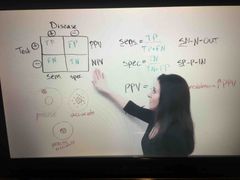
Front (Term) |
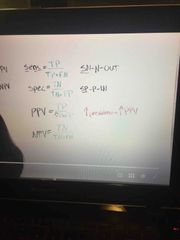
Hhjjgfjh
|
|

Incidence vs prevalence |
incidence: New diagnosed patient with the disease within a year Prevalence: All the people who have the disease right now |
|
|
Case series and cross sectional studies features |
No comparison No intervention Case series measures qualitative and narrative Cross sectional measures prevalence |
|
|
Longitudinal study |
There is a comparison of same groups over time |
|
|
Longitudinal study |
There is a comparison of same groups over time This study measures the change in prevalence |
|
|
Cohort study |
Find the people who had exposure and follow up to see if they will have the disease, and Find the people who didn’t have exposure and follow up to see if they will have the disease This study represented by Relative risk ( RR) |
|
|
Cohort study ( prospective ) |
Find the people who had exposure and follow up to see if they will have the disease, and Find the people who didn’t have exposure and follow up to see if they will have the disease This study represented by Relative risk ( RR) |
|
|
Case-control study ( retrospective) |
Find people who have the disease and look back in their history if they got exposure, And find people who don’t have the disease and look back in their history if they got exposure This study represented by odd ration( OR ) |
|
|
Experimental study ( intervention study) |
If no ones is blinded the study called open label(elevated BIAS) If the blinded ones are the patients the study called single blind stud( less BIAS) If everyone is blinded (patient and researchers) it’s called double blinded study(least BIAS |
|
|
Bias features |
1. subjects: (Hawthorne effect: observation leads to change in behavior Recall: sick patients remember more ) 2. Researchers: Selection:groups differ at the baseline ( separation of the groups) Rx by randomization and matching Observer: affect the researchers evaluation, Rx: double blinding 3.Study: Confounding: when there is a factor( related to both exposure and outcome) interferes between exposure and outcome leading to disturbing the relationship between exposure and outcome, Rx: randomization, matching. Effect modification: same confounding but the factor isn’t associated with exposure which leads to enhance the relationship between exposure and outcome |
|
|
Bias features |
1. subjects: (Hawthorne effect: observation leads to change in behavior Recall: sick patients remember more ) 2. Researchers: Selection:groups differ at the baseline ( separation of the groups) Rx by randomization and matching Observer: affect the researchers evaluation, Rx: double blinding 3.Study: Confounding: when there is a factor( related to both exposure and outcome) interferes between exposure and outcome leading to disturbing the relationship between exposure and outcome, Rx: randomization, matching. Effect modification: same confounding but the factor isn’t associated with exposure which leads to enhance the relationship between exposure and outcome |
|
|
H0 vs Ha hypothesis |
H0: group1= group2 Ha: group 1 doesn’t = group 2 If P is small( < alfa) the H0 is rejected If P is large( > alfa) the H0 is failed to be rejected Alfa(a) significance level= 0.05 |
|
|
Bias features |
1. subjects: (Hawthorne effect: observation leads to change in behavior Recall: sick patients remember more ) 2. Researchers: Selection:groups differ at the baseline ( separation of the groups) Rx by randomization and matching Observer: affect the researchers evaluation, Rx: double blinding 3.Study: Confounding: when there is a factor( related to both exposure and outcome) interferes between exposure and outcome leading to disturbing the relationship between exposure and outcome, Rx: randomization, matching. Effect modification: same confounding but the factor isn’t associated with exposure which leads to enhance the relationship between exposure and outcome |
|
|
H0 vs Ha hypothesis |
H0: group1= group2 Ha: group 1 doesn’t = group 2 If P is small( < alfa) the H0 is rejected If P is large( > alfa) the H0 is failed to be rejected Alfa(a) significance level= 0.05 |
|
|
Increased the sample or size of study make the statistical power? |
High |
|
|
Bias features |
1. subjects: (Hawthorne effect: observation leads to change in behavior Recall: sick patients remember more ) 2. Researchers: Selection:groups differ at the baseline ( separation of the groups) Rx by randomization and matching Observer: affect the researchers evaluation, Rx: double blinding 3.Study: Confounding: when there is a factor( related to both exposure and outcome) interferes between exposure and outcome leading to disturbing the relationship between exposure and outcome, Rx: randomization, matching. Effect modification: same confounding but the factor isn’t associated with exposure which leads to enhance the relationship between exposure and outcome |
|
|
H0 vs Ha hypothesis |
H0: group1= group2 Ha: group 1 doesn’t = group 2 If P is small( < alfa) the H0 is rejected If P is large( > alfa) the H0 is failed to be rejected Alfa(a) significance level= 0.05 |
|
|
Increased the sample or size of study make the statistical power? |
High |
|
|
Probability Vs Odds |
Probability= event/ event + non-event. Odds = event/ non-event |
|
|
Bias features |
1. subjects: (Hawthorne effect: observation leads to change in behavior Recall: sick patients remember more ) 2. Researchers: Selection:groups differ at the baseline ( separation of the groups) Rx by randomization and matching Observer: affect the researchers evaluation, Rx: double blinding 3.Study: Confounding: when there is a factor( related to both exposure and outcome) interferes between exposure and outcome leading to disturbing the relationship between exposure and outcome, Rx: randomization, matching. Effect modification: same confounding but the factor isn’t associated with exposure which leads to enhance the relationship between exposure and outcome |
|
|
H0 vs Ha hypothesis |
H0: group1= group2 Ha: group 1 doesn’t = group 2 If P is small( < alfa) the H0 is rejected If P is large( > alfa) the H0 is failed to be rejected Alfa(a) significance level= 0.05 |
|
|
Increased the sample or size of study make the statistical power? |
High |
|
|
Probability Vs Odds |
Probability= event/ event + non-event. Odds = event/ non-event |
|
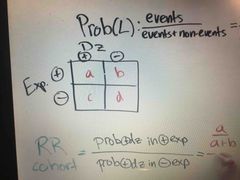
Relative risk ( cohort study) = |
Probability of having a disease in people who exposed / probability of having a disease in people who haven’t exposed |
|
|
Bias features |
1. subjects: (Hawthorne effect: observation leads to change in behavior Recall: sick patients remember more ) 2. Researchers: Selection:groups differ at the baseline ( separation of the groups) Rx by randomization and matching Observer: affect the researchers evaluation, Rx: double blinding 3.Study: Confounding: when there is a factor( related to both exposure and outcome) interferes between exposure and outcome leading to disturbing the relationship between exposure and outcome, Rx: randomization, matching. Effect modification: same confounding but the factor isn’t associated with exposure which leads to enhance the relationship between exposure and outcome |
|
|
H0 vs Ha hypothesis |
H0: group1= group2 Ha: group 1 doesn’t = group 2 If P is small( < alfa) the H0 is rejected If P is large( > alfa) the H0 is failed to be rejected Alfa(a) significance level= 0.05 |
|
|
Increased the sample or size of study make the statistical power? |
High |
|
|
Probability Vs Odds |
Probability= event/ event + non-event. Odds = event/ non-event |
|
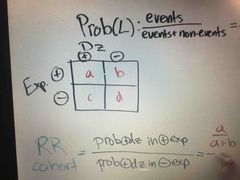
Relative risk ( cohort study) = |
Probability of having a disease in people who exposed / probability of having a disease in people who haven’t exposed شوف البوست التالي |
|
|
Bias features |
1. subjects: (Hawthorne effect: observation leads to change in behavior Recall: sick patients remember more ) 2. Researchers: Selection:groups differ at the baseline ( separation of the groups) Rx by randomization and matching Observer: affect the researchers evaluation, Rx: double blinding 3.Study: Confounding: when there is a factor( related to both exposure and outcome) interferes between exposure and outcome leading to disturbing the relationship between exposure and outcome, Rx: randomization, matching. Effect modification: same confounding but the factor isn’t associated with exposure which leads to enhance the relationship between exposure and outcome |
|
|
H0 vs Ha hypothesis |
H0: group1= group2 Ha: group 1 doesn’t = group 2 If P is small( < alfa) the H0 is rejected If P is large( > alfa) the H0 is failed to be rejected Alfa(a) significance level= 0.05 |
|
|
Increased the sample or size of study make the statistical power? |
High |
|
|
Probability Vs Odds |
Probability= event/ event + non-event. Odds = event/ non-event |
|
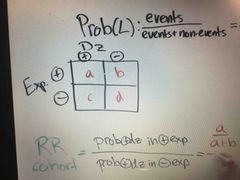
Relative risk ( cohort study) = |
Probability of having a disease in people who exposed / probability of having a disease in people who haven’t exposed شوف البوست التالي |
|
|
RR = |
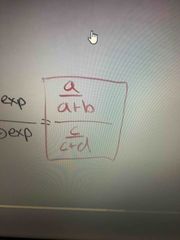
Back (Definition) |
|
|
Bias features |
1. subjects: (Hawthorne effect: observation leads to change in behavior Recall: sick patients remember more ) 2. Researchers: Selection:groups differ at the baseline ( separation of the groups) Rx by randomization and matching Observer: affect the researchers evaluation, Rx: double blinding 3.Study: Confounding: when there is a factor( related to both exposure and outcome) interferes between exposure and outcome leading to disturbing the relationship between exposure and outcome, Rx: randomization, matching. Effect modification: same confounding but the factor isn’t associated with exposure which leads to enhance the relationship between exposure and outcome |
|
|
H0 vs Ha hypothesis |
H0: group1= group2 Ha: group 1 doesn’t = group 2 If P is small( < alfa) the H0 is rejected If P is large( > alfa) the H0 is failed to be rejected Alfa(a) significance level= 0.05 |
|
|
Increased the sample or size of study make the statistical power? |
High |
|
|
Probability Vs Odds |
Probability= event/ event + non-event. Odds = event/ non-event |
|
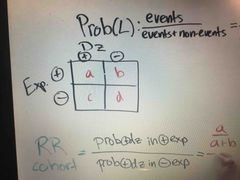
Relative risk ( cohort study) = |
Probability of having a disease in people who exposed / probability of having a disease in people who haven’t exposed شوف البوست التالي |
|
|
RR = |
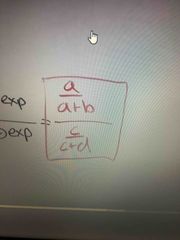
Back (Definition) |
|
|
Bias features |
1. subjects: (Hawthorne effect: observation leads to change in behavior Recall: sick patients remember more ) 2. Researchers: Selection:groups differ at the baseline ( separation of the groups) Rx by randomization and matching Observer: affect the researchers evaluation, Rx: double blinding 3.Study: Confounding: when there is a factor( related to both exposure and outcome) interferes between exposure and outcome leading to disturbing the relationship between exposure and outcome, Rx: randomization, matching. Effect modification: same confounding but the factor isn’t associated with exposure which leads to enhance the relationship between exposure and outcome |
|
|
H0 vs Ha hypothesis |
H0: group1= group2 Ha: group 1 doesn’t = group 2 If P is small( < alfa) the H0 is rejected If P is large( > alfa) the H0 is failed to be rejected Alfa(a) significance level= 0.05 |
|
|
Increased the sample or size of study make the statistical power? |
High |
|
|
Probability Vs Odds |
Probability= event/ event + non-event. Odds = event/ non-event |
|
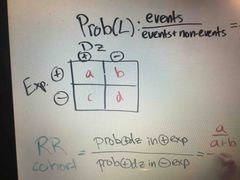
Relative risk ( cohort study) = |
Probability of having a disease in people who exposed / probability of having a disease in people who haven’t exposed شوف البوست التالي |
|
|
RR = Probability of having a disease in people who exposed / probability of having a disease in people who haven’t exposed |
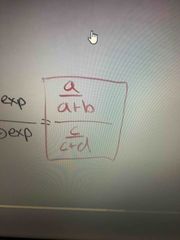
Back (Definition) |
|
|
Bias features |
1. subjects: (Hawthorne effect: observation leads to change in behavior Recall: sick patients remember more ) 2. Researchers: Selection:groups differ at the baseline ( separation of the groups) Rx by randomization and matching Observer: affect the researchers evaluation, Rx: double blinding 3.Study: Confounding: when there is a factor( related to both exposure and outcome) interferes between exposure and outcome leading to disturbing the relationship between exposure and outcome, Rx: randomization, matching. Effect modification: same confounding but the factor isn’t associated with exposure which leads to enhance the relationship between exposure and outcome |
|
|
H0 vs Ha hypothesis |
H0: group1= group2 Ha: group 1 doesn’t = group 2 If P is small( < alfa) the H0 is rejected If P is large( > alfa) the H0 is failed to be rejected Alfa(a) significance level= 0.05 |
|
|
Increased the sample or size of study make the statistical power? |
High |
|
|
Probability Vs Odds |
Probability= event/ event + non-event. Odds = event/ non-event |
|
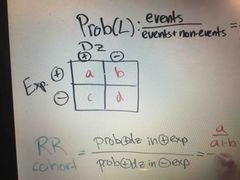
Relative risk ( cohort study) = |
Probability of having a disease in people who exposed / probability of having a disease in people who haven’t exposed شوف البوست التالي |
|
|
RR = Probability of having a disease in people who exposed / probability of having a disease in people who haven’t exposed |
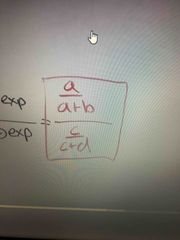
Back (Definition) |
|
|
Odd ratio (OR) in case control study OR= odds of positive exposure in people who have the disease/ odds of positive exposure in people who don’t have the disease |

Back (Definition) |
|
|
Odd ratio (OR) in case control study OR= odds of positive exposure in people who have the disease/ odds of positive exposure in people who don’t have the disease |

Back (Definition) |
|
|
RR or OR values and its meaning |
>1 positive association =1 no association < 1 negative association |
|
|
Never needed to treat( NNT) and never needed to harm( NNH) calculation |
NNT= 1/ ARR ( ARR means absolute risk reduction) NNH= 1/AR ( AR means attributable risk) |
|
|
Relative risk redaction ( RRR) |
RRR=1- RR |
|
|
الحمد لله ربي نجحني و ارزقني |
و دلني على الاجابة الصحيحة يا الله |
|
|
If the confidence interval contain the Null vale ( 1.0) the P will be |
> 0.05 But if doesn’t contain the the null vale the P will be < 0.05 |
|
|
Risk = |
The number of diseased subjects/ total number of objects |
|
|
يا ربي أنقذني |
و أرشدني الى الاختيار الاصح في الامتحان يا قدير |
|
|
Baseline characteristics are similar in distribution ?? |
Randomization is successful |
|
|
Baseline characteristics are similar in distribution ?? |
Randomization is successful |
|
|
Cross sectional study measured at the |
Same time for the risk factor and outcome simultaneously |
|
|
Cross sectional study measured at the |
Same time for the risk factor and outcome simultaneously |
|
|
The best statistical method to compare the means of two groups?? |
Two sample t test |
|
|
Cross sectional study measured at the |
Same time for the risk factor and outcome simultaneously |
|
|
The best statistical method to compare the means of two groups?? |
Two sample t test |
|
|
The statistical method to Compare more than 2 means ? |
ANOVA |
|
|
Matching is the efficient method to control? |
Confounding |
|
|
Randomization to different interventions with additional study of >2 variables |
Uses of 3 different anti hypertension drugs with 2 deferent variable BP endpoint |
|
|
The difference between the 2 risk estimates( for example at 3 months the relative risk and P value measured then after one year they measured again) best explained ? |
Latency period |
|
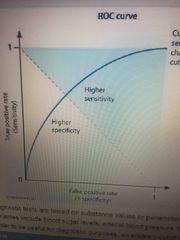
True positive rate and false positive rate representation? |
True positive rate = sensitivity False positive rate= 1- specificity |
|
|
The most effective intervention to improve the quality of patient care ?? |
Pharmacist-direct intervention |
|
|
The tighter the confidence interval the result is more ?? |
Precise |
|
|
Being free of the disease ( انتبه على صيغة الجملة ) is |
Negative predictive value(NPV) patient with high probability of having a disease will have low NPV, while who have low probability of having a disease will have high NPV. |
|
|
Cross sectional study measured at the |
Same time for the risk factor and outcome simultaneously |
|
|
ربي فهمني و علمني |
و دلني على الاجابة الصحيحة يا ربي |
|
|
The best statistical method to compare the means of two groups?? |
Two sample t test |
|
|
The statistical method to Compare more than 2 means ? |
ANOVA |
|
|
Matching is the efficient method to control? |
Confounding |
|
|
Randomization to different interventions with additional study of >2 variables |
Uses of 3 different anti hypertension drugs with 2 deferent variable BP endpoint |
|
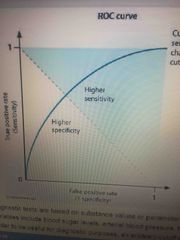
True positive rate and false positive rate representation? |
True positive rate = sensitivity False positive rate= 1- specificity |
|
|
True positive rate and false positive rate representation? |
True positive rate = sensitivity False positive rate= 1- specificity |
|
|
The most effective intervention to improve the quality of patient care ?? |
Pharmacist-direct intervention |
|
|
The tighter the confidence interval the result is more ?? |
Precise |
|
|
Being free of the disease ( انتبه على صيغة الجملة ) is |
Negative predictive value(NPV) patient with high probability of having a disease will have low NPV, while who have low probability of having a disease will have high NPV. |
|
|
Cross sectional study measured at the |
Same time for the risk factor and outcome simultaneously |
|
|
ربي فهمني و علمني |
و دلني على الاجابة الصحيحة يا ربي |
|
|
The best statistical method to compare the means of two groups?? |
Two sample t test |
|
|
The statistical method to Compare more than 2 means ? |
ANOVA |
|
|
Matching is the efficient method to control? |
Confounding |
|
|
Randomization to different interventions with additional study of >2 variables |
Uses of 3 different anti hypertension drugs with 2 deferent variable BP endpoint |
|
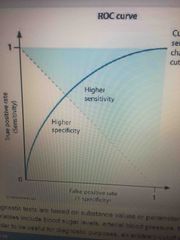
True positive rate and false positive rate representation? |
True positive rate = sensitivity False positive rate= 1- specificity |
|
|
True positive rate and false positive rate representation? |
True positive rate = sensitivity False positive rate= 1- specificity |
|
|
The most effective intervention to improve the quality of patient care ?? |
Pharmacist-direct intervention |
|
|
The tighter the confidence interval the result is more ?? |
Precise |
|
|
Being free of the disease ( انتبه على صيغة الجملة ) is |
Negative predictive value(NPV) patient with high probability of having a disease will have low NPV, while who have low probability of having a disease will have high NPV. |
|
|
Correlation coefficient |
Shows the strength and the direction of the association |
|
|
If the confidence interval contain the null value(1.0) it means the study is |
Not statistically significant and the P vale will be > 0.05 In contrast when the confidence interval doesn’t contain the null value ( 1.0) the study will be statistically significant and the P value will be < 0.05 |
|
|
If the confidence interval contain the null value(1.0) it means the study is |
Not statistically significant and the P vale will be > 0.05 In contrast when the confidence interval doesn’t contain the null value ( 1.0) the study will be statistically significant and the P value will be < 0.05 |
|
|
احفظ هاد التشارت و استخدم قوانينك نفسها و بالعقل |
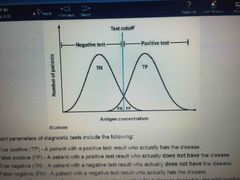
Back (Definition) |
|
|
If the test is negative the probability of having a disease is |
1-negative predictive value |
|
|
If the test is negative the probability of having a disease is |
1-negative predictive value |
|
|
Standard deviation |
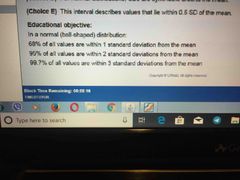
Back (Definition) |
|
|
Cphort study compare ?? |
The disease incidence |
|
|
Case control study compare ? |
Risk factor frequency |
|
|
Clinical trial compare ? |
For outcome of interest |
|
|
Cross sectional study compare |
Disease prevalence |
|
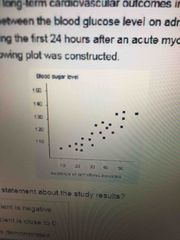
Scattered plots can demonstrate the type of association?? |
Linear, non linear..etc |
|
|
Prevalence and PPV/NPV chart |
Increased prevalence: increased PPV, decreased NPV Decreased prevalence: decreased PPV, increased NPV |
|
|
The test improves the prognosis of patient with the disease, what is the potential problem in this statement? |
Lead-time bias |
|
|
The test improves the prognosis of patient with the disease, what is the potential problem in this statement? |
Lead-time bias |
|
|
Some of the groups members are lost to follow up by the end of the study and weren’t included in the final result, bias?? |
Selection bias |
|
|
In rare diseases ( like toxic shock syndrome) the odds ration is approximately equal?? |
To relative risk |
|
|
The statistical method to assess proportions ( schedule 2*2 ) is |
Chi-square test |
|
|
The statistical method to assess proportions ( schedule 2*2 ) is |
Chi-square test |
|
|
Attributed risk percentage(ARP) |
ARP= (RR-1)/RR |
|
|
The statistical method to assess proportions ( schedule 2*2 ) is |
Chi-square test |
|
|
Attributed risk percentage(ARP) |
ARP= (RR-1)/RR |
|
|
الحمد لله ربي ذكرني ما كتبت و قرأت |
و دلني على الاجابة الصحيحة في الامتحان يا الله |
|
|
الحمد لله ربي ذكرني ما كتبت و قرأت |
و دلني على الاجابة الصحيحة في الامتحان يا الله |

